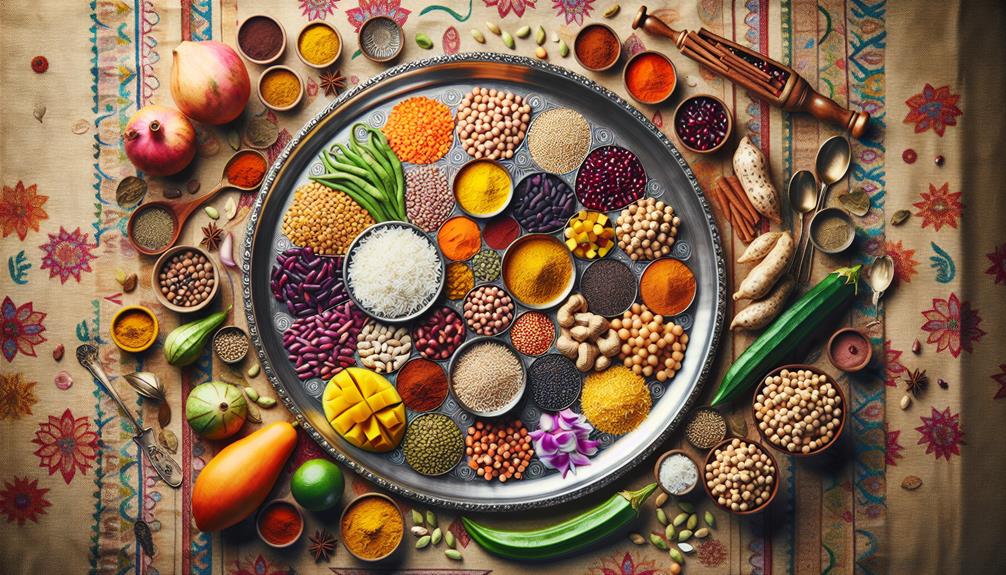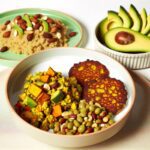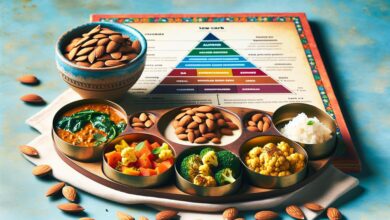Embarking on a vegan lifestyle can be a transformative journey, particularly when infused with the rich tapestry of Indian culinary traditions. However, maintaining a nutritionally balanced and culturally authentic Indian vegan diet need not be an expensive endeavor. Our comprehensive guide offers 13 pragmatic tips tailored to support health-conscious individuals seeking to harmonize their ethical choices with financial prudence. From embracing the abundance of locally-sourced seasonal produce to the strategic purchase of bulk legumes and grains, we underscore the importance of a well-planned approach. Moreover, the guide also illuminates how the incorporation of local spices and simple, traditional dishes can not only enhance flavor but also ensure affordability. As we present these insights, we invite you to consider how these strategies might be seamlessly integrated into your daily routine, promising a sustainable and flavorful vegan diet that aligns with the principles of both wellness and economy.
Key Takeaways
- Prioritize seasonal produce and buy bulk legumes and grains to save money on an affordable vegan Indian diet plan.
- Growing herbs at home can save money compared to purchasing packaged herbs and provide a more vibrant taste experience.
- Incorporating whole foods like fresh produce, whole grains, and protein-rich legumes supports affordability, health, local economy, and the environment.
- Limiting processed items and focusing on homemade sauces, dressings, and whole fruits, nuts, and seeds can help save money and improve nutrition on an affordable vegan Indian diet plan.
Prioritize Seasonal Produce
Embracing the abundance of seasonal produce not only economizes your vegan Indian diet but also ensures you indulge in the most vibrant and nutrient-dense ingredients available. Seasonal fruits and vegetables offer a symphony of flavors and health benefits, deeply rooted in India’s rich agricultural tapestry. By prioritizing these items, one can experience the genuine essence of traditional Indian cuisine while maintaining a health-conscious lifestyle.
Seeking out local farmer’s markets or community-supported agriculture (CSA) programs can be a cost-effective strategy for acquiring fresh seasonal produce. These venues often provide a wide array of local fruits and vegetables at competitive prices due to their abundant supply. This practice supports local farming communities and fosters a sustainable food system that minimizes transportation, thereby reducing carbon footprint and preserving the nutritional integrity of the produce.
When meal planning, centering your dishes around the seasonal bounty not only stretches your budget but also invites creativity and diversity into your vegan Indian diet. Integrate these seasonal offerings into classic Indian recipes to enhance flavor profiles and nutritional value. By doing so, you contribute to a culture of wellness, serve others by sharing knowledge about nutritious eating, and help sustain the environment for future generations.
Buy Bulk Legumes and Grains
Building on the foundation of incorporating seasonal produce, a vegan Indian diet can further benefit from the economical practice of buying legumes and grains in bulk. Legumes, including lentils, chickpeas, and beans, alongside grains such as brown rice and quinoa, are cornerstones of Indian cuisine and provide essential protein for those following a plant-based diet. Buying these staples in large quantities is not only cost-effective but also ensures you have versatile ingredients at hand for creating a myriad of nutritious and satisfying meals.
Investing in bulk purchases of legumes and grains leads to significant long-term savings. These foods typically have an extended shelf life, allowing them to be stored for long periods without loss of quality, making them ideal for a conscientious household that values both health and economy. Moreover, this practice aligns with cultural values of sustainability and care for the environment by reducing packaging waste.
Opt for Local Spices
Incorporating a diverse range of local spices not only imbues your vegan Indian dishes with rich, authentic flavors but also offers considerable health benefits. When you choose local herbs and spices, you not only support regional agriculture but also ensure the freshness and potency of your ingredients. The aromatic world of Indian cuisine is largely defined by its use of spices, which can elevate the simplest ingredients to new culinary heights.
Here are some ways to integrate local spices into your meals:
- Experiment with Essentials: Start with staples like cumin, coriander, turmeric, and mustard seeds to build a foundation of flavor.
- Cost-Effective Choices: Buying local often means better prices for better quality, reducing the cost of your vegan diet.
- Health-Minded Selections: Take time to research the medicinal properties of spices like turmeric, which is known for its anti-inflammatory effects.
- Custom Blends: Create your own spice mixes to cater to your taste and health needs, making your vegan dishes uniquely personal and nutritionally rich.
Local spices are more than just flavor enhancers; they are a fusion of tradition, health, and community. By opting for local herbs and spices, you contribute to a sustainable diet that is both culturally immersive and conducive to well-being.
Plan Weekly Meals
Strategically planning your meals on a weekly basis is a cornerstone practice for maintaining an organized, health-focused, and culturally rich vegan Indian diet. A well-structured Meal Plan ensures that you can prepare nutritious meals that align with your cultural preferences and dietary needs while also being mindful of your budget.
Creating a shopping list that corresponds with your Meal Plan is fundamental to avoid impulsive purchases and helps in making cost-effective decisions. This approach allows you to focus on acquiring only the necessary ingredients for your planned dishes, reducing waste and promoting financial savings.
Batch-cooking can be a lifesaver for those with busy schedules, allowing you to have ready-made wholesome meals at hand. This method also reduces the frequency of cooking, saving time and energy throughout the week. Moreover, being creative with leftovers by repurposing them into new meals ensures that every bit of your food is utilized, honoring the principle of non-wastage.
Below is a sample weekly Meal Plan table that incorporates these tips:
| Day | Meal | Notes |
|---|---|---|
| Monday | Chana Masala | Utilize batch-cooked chickpeas |
| Tuesday | Aloo Gobi | Repurpose leftover cauliflower |
| Wednesday | Dal Tadka | Cook extra for Thursday’s lunch |
| Thursday | Dal Paratha | Use Wednesday’s leftover dal |
| Friday | Veg Biryani | Prepare rice in bulk for weekend meals |
Integrating these practices into your lifestyle can transform your culinary experience, allowing you to serve both yourself and others with meals that are as nourishing as they are delightful.
Use Economical Protein Sources
Having emphasized the importance of meal planning and budget-friendly practices, it is equally vital to focus on the selection of affordable protein sources, such as lentils, chickpeas, and black beans, to maintain a nutritionally complete vegan Indian diet. These plant-based proteins are not only cost-effective but also culturally resonant with traditional Indian cuisine, providing the foundation for many staple dishes.
To ensure that your vegan Indian diet is both affordable and protein-rich, consider the following:
- Lentils: A staple in Indian cooking, lentils are versatile and can be used in dals, soups, and salads.
- Chickpeas: Ideal for chana masala or hummus, chickpeas are a hearty addition to any meal.
- Tofu and Edamame: These soy-based proteins are excellent in curries and stir-fries.
- Black Beans: Though not traditionally Indian, black beans can be incorporated into dishes for variety and added protein.
Grow Your Own Herbs
Cultivating a personal herb garden offers a cost-effective and sustainable method to enhance the flavors in vegan Indian cooking, while also embracing the joy of harvesting your own fresh ingredients. Integrating home-grown herbs into your meals not only saves money compared to purchasing packaged varieties but also provides a more vibrant taste experience. The rich tapestry of Indian cuisine is known for its exquisite use of herbs and spices, which are central to creating authentic flavors.
Many commonly used herbs such as basil, cilantro, and mint are remarkably easy to grow indoors, making it convenient for those with limited outdoor space. These herbs require minimal care, yet they flourish, providing an ongoing source of freshness for your culinary creations. The act of growing your own herbs is a step towards a more sustainable lifestyle, significantly reducing the packaging waste and carbon footprint linked with store-bought alternatives.
There is an undeniable health benefit and cultural enrichment in incorporating freshly picked herbs into your vegan Indian diet. In addition to their gustatory contributions, they offer various nutritional advantages. Furthermore, the satisfaction derived from nurturing and utilizing home-grown herbs in service of delicious, healthful meals cannot be understated, reinforcing a deep connection with the food we eat and share with others.
Incorporate Whole Foods
Building upon the foundation of enhancing meals with home-grown herbs, incorporating a variety of whole foods into your vegan Indian diet is essential for achieving both nutritional balance and culinary diversity. Whole foods, which include fruits, vegetables, whole grains, legumes, and nuts, are the cornerstone of a nourishing plant-based diet. They provide a rich array of nutrients and fiber, promoting satiety and overall health.
To ensure your meals are as enriching as they are flavorful, consider these tips:
- Prioritize fresh, seasonal produce to get the best taste and nutritional value.
- Opt for a colorful plate, including a variety of vegetables and fruits, to benefit from a wide spectrum of vitamins and antioxidants.
- Integrate whole grains like brown rice and millet to add heartiness and texture to your dishes.
- Include protein-rich legumes such as lentils, chickpeas, and beans, which are staples in Indian cuisine.
Choosing whole foods over processed ones not only contributes to a more affordable and health-conscious lifestyle but also supports the local economy and reduces environmental impact. By experimenting with different whole food ingredients and recipes, you can keep your vegan Indian meals exciting and culturally authentic while serving and nourishing others with mindful, sustainable choices.
Limit Processed Items
Shifting focus from whole foods to processed items, it is imperative to limit the latter in your diet to maintain both economic and nutritional efficiency within a vegan Indian lifestyle. Processed items often come with a higher price tag and fewer nutritional benefits compared to their whole food counterparts. Embracing a diet rich in whole grains, legumes, and fresh produce is not only more culturally authentic but also more beneficial for your health and wallet.
Opting for homemade sauces and dressings can significantly cut down on the cost and unwanted additives found in store-bought versions. Additionally, packaged snacks, while convenient, are rarely as satisfying or nutritious as whole fruits, nuts, and seeds. These natural options are deeply rooted in Indian culinary traditions and serve as excellent sources of energy and nutrients.
Preparing meals from scratch is a hallmark of Indian cuisine and is conducive to a vegan diet. It eliminates the added expense and hidden ingredients of pre-packaged convenience foods. By focusing on fresh ingredients and traditional cooking methods, one can enjoy a diverse, flavorful, and affordable vegan Indian diet that honors both cultural heritage and personal health.
Cook in Batches
Embracing the practice of batch-cooking can be a game-changer for adherents of a vegan Indian diet, offering economies of scale that save both time and financial resources. By preparing large quantities of staples like rice, lentils, and curries, one can streamline meal preparation throughout the week. This approach not only ensures consistent access to nutritious, home-cooked meals but also contributes to a sustainable lifestyle by reducing food waste.
Consider these tips when batch-cooking your vegan Indian meals:
- Plan Ahead: Sketch out your weekly menu, focusing on recipes that are both nutritious and freezer-friendly, such as dal seasoned with cumin seeds and turmeric.
- Cook Strategically: Prepare base ingredients like grains and legumes in bulk, and use them in different recipes across the week.
- Store Wisely: Invest in quality, airtight containers to keep your food fresh and to avoid spoilage.
- Season Sensibly: Toast spices like cumin seeds in larger batches to enhance flavor, but add fresh herbs closer to serving to maintain their vibrant taste and nutritional value.
Reduce Food Waste
Minimizing food waste is a crucial aspect of following an affordable vegan Indian diet, as it aligns with the principles of environmental sustainability and economic efficiency. Planning meals ahead of time is instrumental in avoiding unnecessary purchases that may lead to waste. By being mindful of portions and shopping lists, we respect the resources and effort that go into our sustenance. Additionally, cooking larger quantities and enjoying leftovers ensures that every grain and chia seed provides its full potential of nourishment and flavor, rather than being discarded.
Using every part of the vegetable, such as making broth from scraps, not only honors the food but also infuses our meals with the essence of prudence and gratitude. Composting organic refuse not only reduces landfill contributions but also enriches the soil, completing a cycle of life that supports the very agriculture we depend on.
Let us reflect on the table below, which emphasizes the emotional and ethical significance of reducing food waste:
| Action | Benefit | Emotional Impact |
|---|---|---|
| Planning Meals | Saves Money | Empowerment |
| Batch-Cooking | Saves Time | Satisfaction |
| Creative Leftovers | Culinary Exploration | Joy |
| Homemade Broth | Nutrient Utilization | Respect |
| Composting | Soil Nourishment | Hope |
Explore Street Food Recipes
Building on the foundation of meal prepping and mindful consumption, exploring street food recipes offers a window into the diverse and flavorful world of vegan Indian cuisine, providing cost-effective and culturally rich meal options. Street food in India is renowned for its variety and taste, often featuring bold spices and fresh ingredients that can inspire your vegan meal plan. By incorporating traditional street food recipes into your diet, you can enjoy the essence of Indian cuisine while adhering to a vegan lifestyle.
Here are some street food-inspired dishes to consider:
- Aloo Chaat: Potatoes tossed with spices and served with mint chutney, offering a tantalizing mix of flavors.
- Bhel Puri: A puffed rice dish with vegetables and tangy tamarind sauce, perfect for a light yet satisfying snack.
- Vegan Samosas: Stuffed with spiced potatoes, peas, and lentils, these pastries can be baked instead of fried for a healthier option.
- Masala Dosa: Fermented crepe filled with spiced potatoes, served with coconut chutney and sambar, making for a hearty meal.
Incorporating these recipes into your diet not only supports a health-conscious lifestyle but also pays homage to the rich culinary heritage of India, allowing you to serve and enjoy meals that are both nutritious and culturally authentic.
Embrace Simple Dishes
Transitioning to simpler dishes within a vegan Indian diet not only streamlines the cooking process but also ensures a sustainable and economical approach to meal planning. By focusing on basic, easy-to-prepare meals that utilize minimal ingredients, individuals can save both time and money. These straightforward recipes often require fewer cooking steps and shorter preparation times, making them ideal for those with busy schedules or limited kitchen resources.
Opting for simple dishes does not mean compromising on taste; the rich tapestry of herbs and spices inherent to Indian cuisine can elevate even the most basic ingredients into a delectable meal. Staples such as rice, lentils, and seasonal vegetables can be transformed with the right combination of spices, ensuring that meals are not only affordable but also rich in flavor and nutrition.
Moreover, simple dishes typically use staple ingredients that are readily available and cost-effective, supporting a sustainable vegan lifestyle. By embracing dishes that minimize the need for expensive or difficult-to-source ingredients, individuals can maintain a consistent and balanced diet, while also catering to the needs of others through shared meals that are both nourishing and culturally authentic.
Learn Preservation Techniques
While embracing simple dishes is a cornerstone of an affordable vegan Indian diet, mastering preservation techniques can further enhance the sustainability and cost-effectiveness of one’s culinary repertoire. Safeguarding the longevity of fresh produce and ingredients not only mitigates food waste but also ensures a steady supply of nutritious staples. Careful preservation aligns with the Indian ethos of ‘Annadaata Sukhibhava’—may the provider of food be happy—by respecting the bounty provided to us.
Implementing preservation methods allows for a harmonious blend of health-conscious living with cultural traditions, enabling one to maintain a rich variety of flavors in their diet. Here are some effective techniques:
- Freezing: Preserve seasonal produce and herbs and spices by freezing them, maintaining their flavor and nutritional value.
- Pickling: Create tangy, spiced pickles—a staple in Indian cuisine—that can accompany meals throughout the year.
- Canning: Utilize canning for making homemade jams and sauces from surplus fruits and vegetables.
- Dehydrating: Dry herbs and seasonal fruits, ensuring a supply of these essential flavor enhancers for your vegan dishes.
Incorporating these preservation techniques into your routine not only enriches the diet but also fosters a sustainable and thoughtful approach to food consumption.
Frequently Asked Questions
How Can I Make My Vegan Diet Affordable?
To cultivate cost-effectiveness in your vegan regimen, embrace budget shopping. Strategically plan meals, utilize discounts, and opt for non-organic produce to nourish both your health and community without financial strain.
Vegans on a Tight Budget?
Vegans on a budget can prioritize nutrition by selecting cost-effective staples like legumes and grains, planning meals, and taking advantage of discounts, ensuring they meet dietary needs while serving their communities effectively.
How to Do the 7 Day Vegan Challenge?
To successfully undertake a 7-day vegan challenge, one must thoughtfully plan their diet transition, ensuring it is nutritionally balanced to effectively serve their body’s needs while embracing a compassionate lifestyle.







